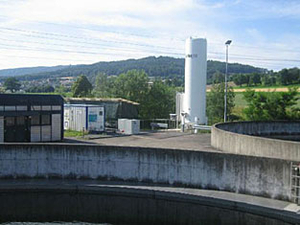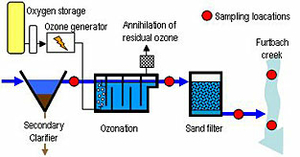Department Process Engineering
Pilot study Regensdorf
Together with other partners, Eawag conducted a full-scale pilotstudy within the FOEN-project “Strategy Micropoll” on the WWTP Regensdorf in order to assess the applicability of ozonation as an advanced treatment technology to remove micropollutants from treated wastewater. It was shown that ozonation eliminated a broad range of organic micropollutants and various ecotoxicological effects. The pilot study also showed that the implementation of an ozonation step in an existing WWTP is feasible, both technically and economically.ist.

Oxygen tank, ozone generator and filtration building WWTP Regensdorf
WWTP Regensdorf
The WWTP Regensdorf treats wastewater for the population of around 15'000 inhabitants and 10’000 person equivalents from industry, using a state-of-the-art process with mechanical treatment, activated sludge system for nitrification and denitrification with simultaneous phosphate precipitation followed by sandfiltration of the secondary effluent. The effluent values are within the existing legal limits for classical parameters (e.g. nutrients, organic matter, suspended solids). The wastewater from the WWTP Regensdorf nearly doubles the water flow in the receiving Furtbach creek. During the pilot experiment, ozone was produced from liquid oxygen and mixed with the biologically treated effluent in the existing flocculation tank, which was slightly modified for the experiment.

Flowscheme of the ozonation step on WWTP Regensdorf. Ozone was produced from liquid oxygen and injected into the existing, but modified flocculation reactor between secondary clarifier and sandfiltration. Red dots indicate sampling points.
Analytics
In order to assess the efficiency of ozonation, samples from different locations on the WWTP were analyzed (see Figure above). More than 50 organic micropollutants, which are not completely degraded in the WWTP during secondary treatment, were measured by Eawag’s department for Environmental Chemistry (e.g. hormones, biocides, pharmaceuticals). Some of these substances lead to adverse effects in Swiss surface waters strongly influenced by treated waste water, as it has been shown for the endocrine disruptors.
Ozonation resulted in a significant reduction both of the number of measurable substances and their concentrations in the final effluent. For example the whole group of antibiotics and other problematic substances were completely removed even at low ozone doses. However, iodinated X-ray contrast media were only partially removed. The efficiency of ozonation therefore depends on both the ozone dose and the characteristics of specific substances (see Figure below). The results of the chemical trace analysis were confirmed by various ecotoxicological assays (e.g. by the department of Environmental Toxicology), where for example a complete elimination of estrogenicity and herbicidal effects was observed.

Influence of the ozone dose on the elimination efficiency of selected, persistent micropollutants. The substances in the upper half are completely eliminated already with low ozone doses, while the substances below are more persistent towards ozonation.
Side-products
Neither chemical nor ecotoxicological investigations detected stable and problematic reaction products in the final effluent. Some studies indicated that labile reaction products were detected directly after the ozonation step. However, they completely disappeared in the final effluent after the sandfiltration. These results point to the necessity of a final, biologically active treatment step after ozonation - similar to the sandfiltration. A very positive effect of ozonation was the significant removal of pathogens with E.coli effluent concentrations far below the EU bathing water directive.
Operation
The ozonation was operated without major breakdowns. Furthermore, it has been successfully operated by the WWTP staff. The applied processes, equipment and safety measures proved to be accurate. However, there is some optimization potential with the measurement devices and control concept. The energy demand of the WWTP was increased by 15% for the ozonation, corresponding to the energy demand of the current sandfiltration. The ozonation could be easily implemented in the existing WWTP. A permanent installation of an ozonation step on the WWTP Regensdorf would result in a cost increase of around 10% for operation and amortization (excluding the sandfiltration).
Conclusions
The pilot study showed that the implementation of an ozonation step in a WWTP results in a significant load reduction of problematic organic micropollutants from wastewater into the surface waters. With this technology, an even better water quality can be achieved in surface waters with a high fraction of treated wastewater. According to today’s knowledge, the ozonation of biologically treated municipal wastewater does not produce significant amounts of problematic reaction products.
Publications
Hollender, J., Zimmermann, S.G., Koepke, S., Krauss, M., McArdell, C.S., Ort, C., Singer, H., von Gunten, U., Siegrist, H. (2009). Elimination of organic micropollutants in a municipal wastewater treatment plant upgraded with a full-scale post-ozonation followed by sand filtration. Environmental Science and Technology, accepted.
Escher, B. I., Bramaz, N., Ort, C. (2009). Monitoring the treatment efficiency of a full scale ozonation on a sewage treatment plant with a mode-of-action based test battery. Journal of Environmental Monitoring, accepted.
